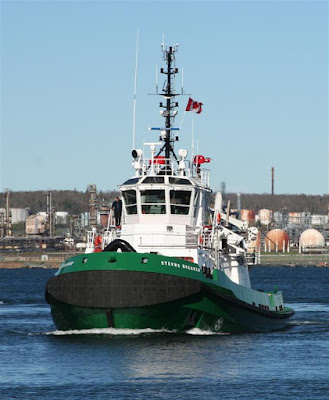.jpg)
Atlantic Towing currently has no operational tugs in Halifax. This situation was brought about by a strange sequence of events.
First Atlantic Spruce was sent off on another assignment and so left only two Atlantic Towing tugs in Halifax.
Then the drydock Scotiadock II sank at Halifax Shipyard Saturday while docking Stevns Breaker. (see update below) This resulted in the remaining two tugs Atlantic Larch and Atlantic Oak heading off to fetch barges for the salvage work. Larch left Saturday evening for Point Tupper to get the barge Atlantic Tuna and tow it back to Halifax. I don't know where Oak went, but I assume it was on a similar mission.
Meanwhile the tug Atlantic Elm is in another drydock (the graving dock) at Halifax Shipyard and is out of service. The dredging tugs Atlantic Poplar and Swellmaster are in Halifax, but are in seasonal layup and also unserviceable-they would be unsuitable for ship berthing in any event.
At Point Tupper, the tug Atlantic Beech was sent out to take the tanker Algosea in tow. That ship had a gearbox failure and was towed in to Sydney on Saturday.
This may be good news for rival Svitzer Canada, as its tugs are the only berthing tugs in Halifax for now, and were handing all traffic today. In the photo above Svitzer Bedford has the stern line and Point Chebucto has just secured alongside a post-Panamax container ship. Atlantic Towing has the contract to berth OOCL ships, but oddly this ship is now carrying the Hapag-Lloyd name Vietnam Express, so this may have been Svitzer's job anyway.
.jpg)
.jpg)


.jpg)

.JPG)
.JPG)
.JPG)
.JPG) 4. Sister Mobile's barge is shown here while being moved by tugs in Halifax December 6, 2001. The tongue is to the right, the bow to the left.
4. Sister Mobile's barge is shown here while being moved by tugs in Halifax December 6, 2001. The tongue is to the right, the bow to the left..JPG)
.jpg)
.jpg)
.JPG)
.JPG)
.JPG)
.jpg)
.jpg)

.jpg)
.jpg)
.jpg)
.jpg)
.jpg)
.jpg)

.jpg)
.JPG)
.jpg)
.jpg)
.jpg)
.jpg)
.JPG)
.jpg)
.JPG)
.JPG)
.jpg)
.JPG)
.jpg)
.jpg)